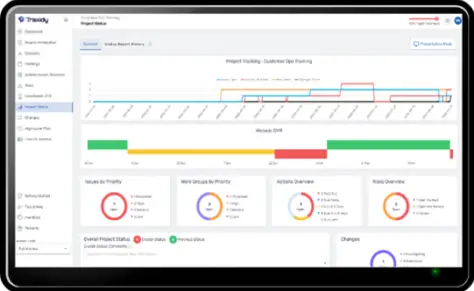

Your Project Change Management Should Never be a Surprise

By: Steve McBroom, CEO, Traxidy
(Click to follow me on LinkedIn)
You’re on a tight project schedule and you’ve been managing multiple unplanned work activities to keep your project on track as planned. Ultimately, the situation leaves you with no alternative but to request a change. The first conversation with your Sponsor regarding a project change does not go very well. The Sponsor wants the project to be delivered as per the agreed upon plan with the same time, cost and scope that was approved at the start. Even if you can get past this situation, you learn that the approval process for a major project change takes time. In this case it will take three weeks before a project change request can even be presented.
Often Project Managers will make assumptions about how to manage project changes, perhaps because of experience and previous engagements with a Sponsor.
The key aspects of how a project will be managed often depends on an organization’s project management culture. There may be very specific processes in place, but the use of these processes throughout a project’s lifecycle and the way in which the key stakeholders follow those processes, can vary widely.
Often Project Managers will make assumptions about how to manage project changes, perhaps because of experience and previous engagements with a Sponsor. That can be a big mistake.
Don't Wait
Don’t wait. The best time to confirm and/or challenge your assumptions is before the project gets underway. Project Managers need to take the time before any real project activity begins. You need to fully understand the way in which project changes will be handled for a specific project and for a specific Sponsor.
Getting early clarification on the expectations for the project change management process, from communication to reporting, will help to prevent major issues to the project and your reputation once the project is in flight.
Both Project Communication and Project Change Management are critical processes that a Project Manager needs to be aware of, and embrace for each project.
We’ll review a simple way in which to ensure you are fully prepared to manage project changes, no matter what your level of understanding or experience is with the Sponsor or the organization you’re part of.
Get Right to the Point in this Blog Post
Clarify Expectations: Play ‘What if …’
As early as possible and before the project starts is the time to gather details on how your Sponsor expects the project change management process to be used. Clarification will come from their answers to essential questions that you can ask, long before you actually need to use the project change process.
Play ‘What if …’ with your Sponsor. No really! Pretend the project is fully underway.
Your success as the Project Manager will be in recognizing that the answers often vary from project to project and stakeholder to stakeholder. Learning this technique will help you stay in control of your project and enable you to be fully prepared to manage most and any situation as it arises.
Play ‘What if …’ with your Sponsor. No really! Pretend the project is fully underway and think about what might be happening in the upcoming project execution or delivery phases. It could be several sprints or iterations ahead in time. Dream up multiple project situations that might eventually happen, and that could drive needed project changes. The pretend situations don’t need to have anything to do with the potential risks for the project. They are completely made-up.
The key is to have this ‘what if’ session with your Sponsor long before the project has actually started.
Present the project change situations to the Sponsor. Listen carefully. Gauge their response. Do the answers fit with the usual project change management process? What can you learn from your Sponsors expectations for the details to communicate in reports and for the timing of the communication?
These answers are specifically from your Sponsor or Customer, and should be adhered to. If the answers completely conflict with organizational or PMO norms, you will need further discussion to ensure everyone is in agreement on the approach.
The key is to have this ‘what if’ session with your Sponsor long before the project has actually started. At a time when there is zero pressure to keep the project on track or to resolve any pressing problems.
Once the project starts, you can expect different types of project changes like the end date or delivery date needs to be extended, the costs will not cover the current project, the scope may need to change to meet the deadline for delivery, and costs have increased with the scope changes. Consider that potential changes could happen at various points in the project lifecycle and review and clarify any responses that are not clear.
'What if ...' Questions
Don’t hesitate to use questions that you think have obvious answers. It’s best to ask the questions of your Sponsor anyway. You might be surprised with some of the answers.
Some potential questions that can be posed to your Sponsor or Manager include:
- What if I believe a change is needed to the approved project schedule?
- Are project changes allowed, once we start the project with an approved schedule and plan?
- What process will be used to approve a change in this project?
- Do we have, or always need to use, a Project Change Request form?
- Is the ‘change process’ different depending on the project timing, complexity, type, etc.?
- What specific information is required to be presented to the Sponsor or others, in order to obtain approval and enable the project change?
- What if the project has unplanned work or issues within the project that could potentially drive project changes?
- How soon do I need to inform the Sponsor about the unplanned work?
- When it looks like the unplanned work will not get us back on track, when would I need to start to investigate the impact and plan for a required project change?
- What if I am investigating the possibility of a change to the project scope, time or cost?
- At what point in the investigation of a change, do I need to discuss or present that potential project change information to the Sponsor?
- What specific project change information would the Sponsor expect to see from the investigation?
It is also important to get the Sponsor’s view on the expected processes and timing they would expect you to follow.
All projects are different, and the consideration for changes needs to accommodate your project goals and the Sponsor and organizational expectations. It is critical, as the Project Manager, to understand how willing (or not!?) your Sponsor is to have the scope, time or cost of the project changed once the project is underway.
It is also important to get their view on the expected processes and timing they would expect you to follow. This can vary widely from a Sponsor being adamant that no changes are to be made to a project once it has started, to a Sponsor being supportive of changes throughout the entire process.
Conclusion
Project changes are inevitable and it’s important for Project Managers to clarify the project change management process to help ensure project success.
At the earliest possible time in the project lifecycle and once you’re engaged as the Project Manager, use the ‘what if’ scenario to ask the questions. The questions you can come up with are many and relative to your experience and known challenges.
Placing a focus on project changes, long before there is any pressure or time constraints placed on you, helps to keep your project on track.
This proactive approach will allow you to confirm the Sponsor’s expectations for project changes, communication, reporting information, and the frequency and timing of reports.
Placing a focus on project changes, long before there is any pressure or time constraints placed on you, the Project Manager, helps to keep your project on track and drive positive business outcomes and project success.
Learn more about how Traxidy project tracking software can help Project Managers with a practical approach to project change management for greater success.
Traxidy is the Project Manager App built by Project Managers for Project Managers.
We’re making it easy for you to manage the day-to-day planned and unplanned project work priorities like Project Action Item Tracking, Project Status Reports, Team Meeting Minutes, Risk Log, Change Management, High-Level Plans, and more. Easily track, collaborate, report, save time and increase project success. Learn more about Traxidy here.
Sign up for our Project Manager Insights
Be the first to receive our Traxidy Blog and Project Manager Insights right to your in-box.











